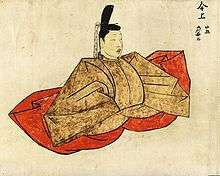Emperor Go-Kōgon
| Go-Kōgon | |
|---|---|
 | |
| 4th Northern Emperor | |
| Reign | 25 September 1352 – 9 April 1371 |
| Predecessor | Sukō |
| Successor | Go-En'yū |
| Born | 23 March 1338 |
| Died | 12 March 1374 (aged 35) |
| Burial | Fukakusa no Kita no Misasagi (深草北陵), Kyoto |
| Spouse | Hirohashi Nakako |
| Issue Among others... | Emperor Go-En'yū |
| Father | Emperor Kōgon |
| Mother | Sanjō Hideko |
Emperor Go-Kōgon (後光厳天皇 Go-Kōgon-tennō) (23 March 1338 – 12 March 1374) was the 4th of the Emperors of Northern Court during the Period of the Northern and Southern Courts. According to pre-Meiji scholars, his reign spanned the years from 1352 through 1371.[1]
This Nanboku-chō "sovereign" was named after his father Emperor Kōgon and go- (後), translates literally as "later;" and thus, he may be called the "Later Emperor Kōgon", or, in some older sources, may be identified as "Emperor Kōgon, the second", or as "Emperor Kōgon II."
Genealogy
His personal name was Iyahito (弥仁).
He was the second son of the Northern Pretender Emperor Kōgon, and brother of his predecessor, Emperor Sukō. His mother was Hideko (秀子), daughter of Sanjō Kinhide (三条公秀)
- Lady-in-waiting: Nakako (仲子), daughter of Hirohashi (Fujiwara) Kanetsuna (広橋(藤原)兼綱)
- Second son: Imperial Prince Ohito (緒仁親王) (Emperor Go-En'yū)
- Fifth son: Prince Eijo (1362–1437;永助入道親王) (Buddhist Lay Priest)
- Sixth son: Prince Gyōnin (尭仁法親王;1363–1430)
- Twelfth son: Prince Gyōsho (尭性法親王;1371–1388) (Buddhist Priest)
- Consort: Uemon-no-Suke no Tsubone (右衛門佐局)
- First son: Imperial Prince Ryōnin (1355–1370;亮仁入道親王) (Buddhist Lay Priest)
- Third son: Imperial Prince Gyojo (行助法親王;1360–1386)
- son: ??? (1361–1369)
- Seventh son: Prince Kakuzō (1363–1390;覚増法親王) (Buddhist Priest)
- Consort: Daughter of Hōin Chōkai (法印長快)
- First daughter: Imperial Princess Haruko (?–1390;治子内親王)
- Fourth son: Prince Kakuei (覚叡法親王) (1361–1377;Buddhist Priest)
- Eighth son: Prince Dōen (道円入道親王) (1364–1385;Buddhist Priest)
- Eleventh son: Prince Shōjo (聖助法親王) (1371–?;Buddhist Priest)
- Consort: Daughter of Tachibana no Mochishige (橘以繁)
- Tenth son: Prince Myōshō (1367–1396;明承法親王) (Buddhist Priest)
- (from unknown women)
- Ninth son: Prince Kanshu (1366–1401;寛守法親王) (Buddhist Priest)
- Thirteenth son: Prince Kankyō (1373–1405;寛教入道親王) (Buddhist Lay Priest)
- Second daughter: Imperial Princess Kenshi (見子内親王)
- Fourteenth son: ???
- Daughter: Shūnin (秀仁) (Buddhist Priestess)
Events of Go-Kōgon's life
In his own lifetime, Go-Kōgon and those around him believed that he occupied the Chrysanthemum Throne from 25 September 1352 to 9 April 1371.
In 1351, Ashikaga Takauji briefly returned to the allegiance of the Southern Dynasty, causing the Southern Court to briefly consolidate control of the Imperial Line. However, this peace fell apart in April 1352. On this occasion, the Southern Court abducted Retired (Northern) Emperors Emperor Kōgon and Emperor Kōmyō as well as Emperor Sukō and the Crown Prince Tadahito from Kyoto to Anau, the location of the Southern Court. This produced a state of affairs in which there was no Emperor in Kyoto. Because of this, Imperial Prince Iyahito became emperor in 1352 with the support of Ashikaga Yoshiakira.[2]
During this period, the Era of the Northern and Southern Courts, because of the antagonism between the two competing dynasties, public order in Kyoto was disturbed. The Southern Court repeatedly recaptured Kyoto. Emperor Go-Kōgon was forced to repeatedly flee from Kyoto to Ōmi Province and other places. Around the time that Ashikaga Yoshimitsu was named shōgun (1368), the Southern Courts power weakened, and order was restored to Kyoto. Also around this time, the Emperor's authority began to show its weakness.
On 9 April 1371, he abdicated in favor of his son, who became Emperor Go-En'yū. He continued to rule as Cloistered Emperor until he died of illness on 12 March 1374. He is enshrined with other emperors at the imperial tomb called Fukakusa no kita no misasagi (深草北陵) in Fushimi-ku, Kyoto.
Eras of Go-Kōgon's reign
The years of Go-Kōgon's reign are more specifically identified by more than one era name or nengō.
- Nanboku-chō Southern court
- Eras as reckoned by legitimate Court (as determined by Meiji rescript)
- Shōhei (1346–1370)
- Kentoku (1370–1372)
- Nanboku-chō Northern court
Southern Court rivals
Notes

References
- Ponsonby-Fane, Richard Arthur Brabazon. (1959). The Imperial House of Japan. Kyoto: Ponsonby Memorial Society. OCLC 194887
- Titsingh, Isaac, ed. (1834). [Siyun-sai Rin-siyo/Hayashi Gahō, 1652], Nipon o daï itsi ran; ou, Annales des empereurs du Japon. Paris: Oriental Translation Fund of Great Britain and Ireland.
See also
| Regnal titles | ||
|---|---|---|
| Preceded by Emperor Sukō |
Northern Emperor 1352–1371 |
Succeeded by Emperor Go-En'yū |